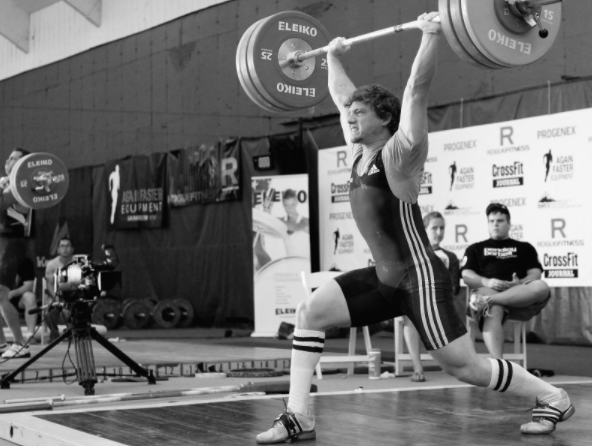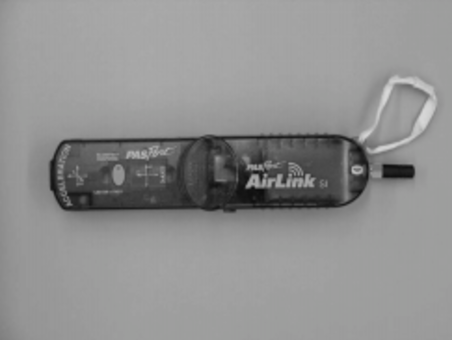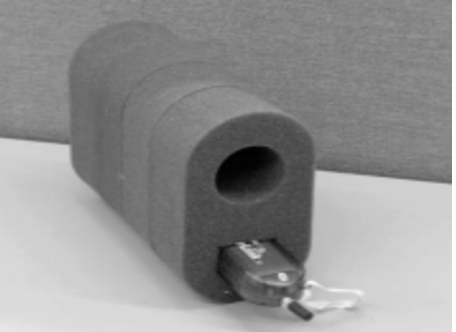By Paul Nguyen
Published January 27, 2017
Overview
A barbell accelerometer is a transmitter capable of measuring the movement speed of a barbell during an Olympic lift. The two olympic lifts, comprising of the snatch and clean & jerk, are common exercises used to train athletes. A barbell accelerometer is designed to measure the speed of a barbell during these two lifts. Using data provided by the accelerometer, one can make informative choices that could improve the performance of the lifts and reduce the chance of injuries.
Introduction to The Olympic Lifts

Figure 1. An athlete performing the clean-and-jerk.
The two olympic lifts are the snatch and the clean & jerk. Both lifts are performed on a standing platform using a barbell and bumper plates. During the two lifts, a barbell starts at the ground and is moved up and over a lifter’s head. (see Figure 1) A barbell is exposed to different level of forces during the lift, causing it to experience a different level of acceleration during each phase (Sato et. al 2009). Depending on the relative position of the barbell, it could either be slowing down or increasing in speed. The changes in accelerations has introduced many questions to coaches and scientists who are intrigued by the elements of the olympic lifts. Unfortunately, for a period of time, there was no way to directly measure a barbell as it is being lifted. The invention of the accelerometer and its recent innovation has made some fortunate changes. The accelerometer is now capable of being attached to a barbell and is able to provide instantaneous feedback to its users.
How it Works
The accelerometer is a small device capable of being attached to the end of a barbell. This device, after being activated, will measure all level of forces acting upon it. For example, if an accelerometer is turned on and is sitting inside a car, when the car moves, the accelerometer will be able to measure the acceleration of the car as it is moving. Inside the device is a sensor that can measure a sudden change in direction when forces are acting upon it. Hence, when attach to a barbell, the accelerometer will measure the acceleration of the barbell as it is rising off the ground during the lifts (Sato et. al 2009). After attaching it to the barbell, users will have to manually initiate the device before performing the lifts. Usually, a coach or assistant will activate the device and monitor the data as an athlete perform the lifts. As the athlete moves the bar, the device will measures the acceleration of the bar until it is turn off remotely by the coach or assistant. Once the lift is completed, the device will send the data it has collected to a nearby computer. In order to attach an accelerometer to a barbell, it must be plugged into its housing unit. A foam shell that holds the accelerometer in a stable position while the barbell is being lifted.
The Accelerometer

Figure 2. An accelerometer, main unit of the left, airlink on the right.
Weighing in at a mere 170.1 gram and no wider than 20.2 cm (Sato et. al 2009). An accelerometer consists of three parts.
The Main Body: The main accelerometer that is used to measure the acceleration of the barbell (see Figure 2).
The AirLink: The housing of the Bluetooth. The Bluetooth add-on allows the device to transmit its data to the recorder (see Figure 2).

Figure 3. An accelerometer inside its housing.
The Housing: A foam shell use to hold the accelerometer (see Figure 3). Its has two openings, one that enables it to be attach to a barbell. Another to hold the device firmly in place during the lift. The foam composition of the shell also served two major purposes. One is to protect the transmitter at the end of the lift, when the barbell is drop to the ground. The foam material absorbs the shock of the lift, protecting it from the drop. Also, the foam material is lightweight. The housing unit and the transmitter itself is light enough so that it does not interfere with the weights that it on the barbell.
The Recorder
A separate device that is connected to an external computer, such as a laptop. The recorder communicates with the accelerometer to collect acceleration data. After collection, data are display for users to view. In order to retrieve data, the designated computer must have an applicable software installed to the system. For the research conducted with this accelerometer, the researchers used Data StudioTM (Sato et. al 2009). After the user has turned off the device once the lift is completed. The data recorded during the movement will appear on the computer. The software will allow users to display their data graphically.
Data Analysis
As mentioned before, the data collected shows the barbell’s acceleration during different phases of the lift. From start to finish, athletes must adjust their body to meet the needs of the movement. Data produced during these movements can have a few implications. If an athlete’s data is showing signs of irregularities, the technique of an athlete could be off, requiring adjustment from the athlete and coach (Sato et. al 2009). If the data shows sign of slow acceleration, an athlete could be suffering from fatigue or is approaching a weight that is beyond the athlete’s range1. Avoiding such implications from the data could lead to overtraining or even injuries (Sato et. al 2009). Thus, data provided by the accelerator can give users a diagnoses of their current situation. This diagnoses will prompt athletes and coaches to make decisions that could help reduce injuries, such as prevention of over-lifting. Or by improving performance, allowing athletes to correct mistake by attempting to fix the irregularities shown in the data that is detected by the device.
Disadvantage of an Accelerometer
Although one of its most beneficial feature allows for its usage, it is also one of its largest downside. The small and nimbleness of the device’s size allows for it to be attached to the barbell, and is also a main reason for its rather short life span. The impact of the barbell once it is drop to ground at the end of a lift has the potential to destroy the transmitter. Even if the transmitter is not destroy in a single blow after the drop. Repetitive usage and drops by the barbell will slowly damage the hardware inside of the accelerometer (Sato et. al 2009). The foam housing of the accelerometer does do its best to protect the device. Unfortunately, the violent nature of the barbell dropping to the ground is something that is very difficult to reduce. Fortunately, due to its widespread usage, accelerometers are relatively inexpensive and easily be replace (Smith et. al 2008).
Human Impact
Implementing an accelerometer into a training regimen that includes the Olympic lifts could greatly enhance efficiency. By providing feedback to coaches and athletes, the device allows for effortless monitoring that could play a role in reducing injuries during training and improve performance during athletic activities. Due to their nature, Olympic lifts tend to be a very common exercise plan in the training regime of many sports (Sato et. al 2009). Improvements in Olympic lifts have the potential to translate into higher power output, which is the force an athlete will produce during strenuous activities, such as sprinting and jumping (Sato et. al 2009). The measurement garner from the transmitter can play a role in indicating the optimal training loads for athletes. The variances display by the data collected may indicate sign of fatigue if the level of power output seems to be lower than usual (Sato et. al 2009). If the data seems to be displaying a higher level of output, this indication could allow adjustments to increase the training volume to fit the athletic ability of an athlete. In the end, the usage of an accelerometer to monitor performance may lead to the ability of quantifying a training regimen, a question that many seek an answer to, this is the famous question asked by all trainers, “How much should one lift?” (Smith et. al 2008). Using this device to improve the efficiency of these lifts by collecting data may lead us closer to this answer. Thus, using this device could help athletes in all types of sports, not just weightlifting.
Summary
Judging the accelerometer by the minimal size will give no implication of the great potential contained within the device. A device that has been adapted to the need of Olympic Weightlifting. This transmitter is capable of collecting and providing instantaneous acceleration data of a barbell during the motion of an Olympic lift. Simple to use, the device provides coaches, athletes and many more the opportunity to see real time data as it is happening on the platform. These data could be use to alter the training regime to fit an athlete’s needs. Either by focusing more on technique to ensure safe and proper lifting, or reducing the training load to prevent an athlete from over-reaching. An integration of an accelerometer could provide a boost to a lifter’s performance when attempting to perform the Olympic lifts. Thus, the accelerometer present an opportunity to reach further into an athlete’s potential and could provide a warning sign when one is reaching too far.
Works Cited
Sato, K. Fleschler, P. Sands, W. (2009). Barbell Acceleration Analysis on Various Intensities of Weightlifting. Retrieved October 15, 2016, from https://ojs.ub.uni-konstanz.de/cpa/article/view/3247
Sato, K. Smith, S. Sands, W. (2008, December). Validation of an Accelerometer for Measuring Sport Performance. Retrieved October 7, 2016, from https://www.researchgate.net/publication/23563688_Validation_of_an_Accelerometer_for_Measuring_Sport_Performance